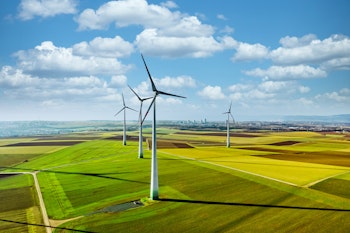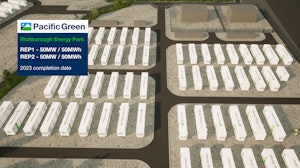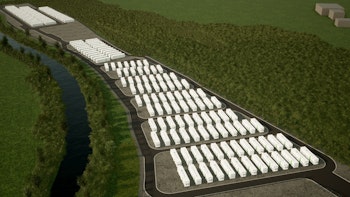The UK is experiencing an unprecedented increase in battery energy storage (BESS) investment and development, with volumes doubling in just one year. And the trend is set to continue for the foreseeable future as the pipeline swells.
According to figures from trade body RenewableUK, released in April of this year, the total capacity of energy storage projects in operation, under construction, consented and in planning now stands at 32 GW. This is nearly twice the total capacity recorded in 2021.
Although less than 1.6 GW of the pipeline is operational and 1.5 GW under construction, as of writing this still represents a 45% year-on-year growth in realised capacity for the UK.
That means that the total installed capacity of utility-scale storage is now approaching 1.7 GW across 127 sites.
According to Solar Media Market Research analyst Mollie McCorkindale, “Annual deployment is expected to rise each year as large-scale projects begin construction, and this is shown by the large pipeline that has built up in previous years.”
Overall, the government has set very ambitious targets for transitioning from carbon-intensive energy...
The UK is attracting investment in energy storage like never before. But what explains the nation’s BESS bonanza? There are several reasons for the mushrooming of energy storage development in the country.
Overall, the government has set very ambitious targets for transitioning from carbon-intensive energy, with nuclear and offshore wind power planned to plug the gap by 2035.
Relying on a highly intermittent energy source such as wind means that energy storage goes from being a nice-to-have capability to an absolute necessity if the country plans on keeping the lights on.
Ease of obtaining planning permission is also an important factor, as the current administration has slashed red tape. Previously, any storage project over 50 MW in England or 250 MW in Wales needed permission from central government.

Now local planning authorities can approve larger projects without the need for central oversight. In fact, gaining planning permission for energy storage is much more straightforward than that for wind farms.
Add to that the vast amounts of land required for a wind farm, and even the most substantial energy storage facility is clearly a much more bankable option for investors.
The change of planning regime may also be the reason UK storage projects are getting larger, as well as considerably more numerous. In previous years, there was more of a mix of project sizes.
In 2021, major projects ranged from 30 MW to 50 MW apiece, with smaller, 5 MW to 30 MW projects becoming less common. Another interesting trend is that most projects are standalone, rather than being co-located with solar or wind projects.
The development of standalone energy storage parks is a cornerstone of Pacific Green Energy Storage’s strategy in the UK. To date, four locations have been earmarked as part of our plans for 1.35 GW of energy storage in the country.

The first phase has already begun at Richborough Energy Park in Kent, with 100 MW of BESS due to be completed in the second quarter of 2023. After that, the 250 MW Sheaf Energy project will be constructed at the same location in 2025.
In addition to employing the latest lithium-ion battery technology, both projects employ real-time smart control systems for energy control and supply. The site has been carefully selected for its strategic position. It once housed a thermal power station which has been demolished.
But the location retains its grid connection, which is now used to bring energy ashore from Thanet Wind Farm, one of the world’s biggest offshore wind projects.
Richborough is also well-situated to service the high-demand populations of Southeast England, including London and its suburbs. In addition, Richborough is a landing point for the 1 GW Nemo Link interconnector to Belgium, which entered commercial service in 2019.
The project has a 35-year operational horizon, incorporating battery augmentations every 10 years. For investors, it offers the assurance of working with a range of highly reputable partners.

After the two Richborough-based projects, additional transmission-level BESS projects are scheduled for completion sometime in 2028 at three locations: Aberthaw in Wales and Canterbury and the Isle of Grain in Kent.
The projects are part of a framework agreement under which Pacific Green and UK-based Tupa Energy collaborate on the development of one of the largest energy storage portfolios in the country.
Under the agreement, Tupa Energy will take care of identifying development opportunities and create early-stage battery storage project companies, with planning consent, a grid connection and a long-term lease agreement with a landowner.
Energy storage is an attractive investment in the UK thanks to its ability to take advantage of multiple revenue opportunities, including capacity and intraday markets, day-ahead auctions, balancing and ancillary services and spot market trading.
Looking at the broader green investment picture, the UK has been gaining ground internationally for several years. Last year, the country took fourth place on EY’s Renewable Energy Country Attractiveness Index.
That puts it ahead of low-carbon energy leaders France and Germany. But recent policy commitments may nudge the nation’s ranking even higher in coming years. The British energy security strategy was published in 2022.
It builds on the government’s ‘Net zero strategy’ and ‘Ten-point plan for a green industrial revolution’ to unlock £100 billion in private investment.
This is helping create a positive environment for BESS, further strengthened by growing interest—not just in the UK, but globally—in cleantech investments.
“There is growing interest in renewables investment from the private sector, particularly in the COVID-19 pandemic era,” says Ben Warren, corporate finance leader in EY’s global power and utilities division.
“Large private investors, such as pension funds and insurers, are increasingly expected—by shareholders, governments and financial regulators—to operate with an eye on environmental, social and corporate governance credentials.”
And it should also help foster a clean energy investment environment where energy storage becomes an essential part of the entire country’s infrastructure.
To find out more about working with Pacific Green to benefit from the tremendous opportunities awaiting investors in the UK energy storage market, contact us now.
Publish date: 26 May, 2022